

Kion - Frequencies - How Sound & Vibrations Can Elevate Your Life. Framework for Information Literacy for Higher Education. Filed by the ACRL Board on February 2, 2015.
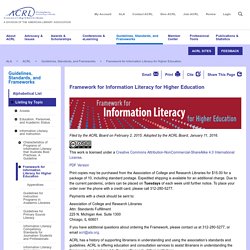
Adopted by the ACRL Board, January 11, 2016. This work is licensed under a Creative Commons Attribution-NonCommercial-ShareAlike 4.0 International License. PDF Version Print copies may be purchased from the Association of College and Research Libraries for $15.00 for a package of 10, including standard postage. Expedited shipping is available for an additional charge. Payments with a check should be sent to: Association of College and Research Libraries Attn: Standards Fulfillment 225 N. If you have additional questions about ordering the Framework, please contact us at 312-280-5277, or email acrl@ala.org. ACRL has a history of supporting librarians in understanding and using the association’s standards and guidelines. Check for upcoming ACRL eLearning webcasts and online courses. ACRL’s Standards, Guidelines, and Frameworks are provided as a free resource to the academic library community. Contents IntroductionFrames Introduction Notes 1. 2. 3. 4. New Alzheimer’s treatment fully restores memory function.
Australian researchers have come up with a non-invasive ultrasound technology that clears the brain of neurotoxic amyloid plaques - structures that are responsible for memory loss and a decline in cognitive function in Alzheimer’s patients.
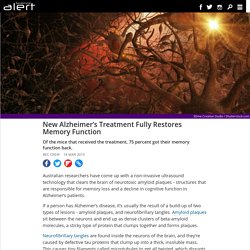
If a person has Alzheimer’s disease, it’s usually the result of a build-up of two types of lesions - amyloid plaques, and neurofibrillary tangles. Amyloid plaques sit between the neurons and end up as dense clusters of beta-amyloid molecules, a sticky type of protein that clumps together and forms plaques. Neurofibrillary tangles are found inside the neurons of the brain, and they’re caused by defective tau proteins that clump up into a thick, insoluble mass. This causes tiny filaments called microtubules to get all twisted, which disrupts the transportation of essential materials such as nutrients and organelles along them, just like when you twist up the vacuum cleaner tube. You can hear an ABC radio interview with the team here. Neuroception: A Subconscious System for Detecting Threats and Safety. • Neuroception describes how neural circuits distinguishwhether situations or people are safe, dangerous,or life threatening.• Neuroception explains why a baby coos at a caregiverbut cries at a stranger, or why a toddler enjoysa parent’s embrace but views a hug from a strangeras an assault.• The Polyvagal Theory describes three developmentalstages of a mammal’s autonomic nervous system:Immobilization, mobilization, and social communicationor social engagement.• Faulty neuroception might lie at the root of severalpsychiatric disorders, including autism, schizophrenia,anxiety disorders, depression, and ReactiveAttachment Disorder.
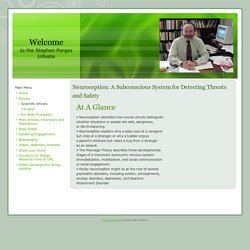
Stephen W. Porges, PhD: Q&A About Freezing, Fainting, and the ‘Safe’ Sounds of Music Therapy. Early humans stalked by brutal killers had a limited choice: Gird for battle or run to safety — as in “fight-or-flight.”
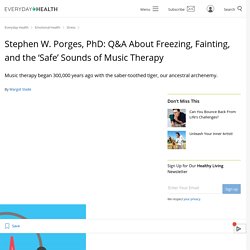
A bit further down the evolutionary road, we added “tend and befriend” to our danger response repertoire, which may have allowed particularly the females among us to protect children and cultivate a social group for mutual defense and support. And that was that — until Stephen Porges, PhD, the Distinguished University Scientist at Indiana University in Bloomington, introduced a third option: freeze or faint.
His widely-cited polyvagal theory contends that living creatures facing or sensing mortal danger will immobilize, even “play dead,” as a last resort. This strategy occurs instinctively — without conscious thought and at the behest of a nervous system quickly deciding whether the environment is dangerous or safe. Safe and Sound Protocol (SSP): Clinical Information and Resources - Integrated Listening. LifeMoves - PrioHealth. “I have been an Occupational Therapist for 38 years.
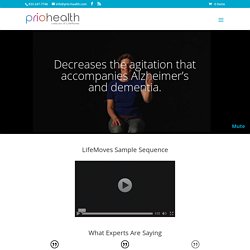
I have worked with people of various abilities and disabilities, ranging in age from 3 months to 101 years, and across clinical settings to include an acute care setting (hospital), nursing home (pediatric), nursing home (geriatric), home care (pediatric and geriatric) and school settings. In all that time, and across all ages, settings, and abilities, the key component of successful therapy intervention is for the client to be able to focus on treatment. Without focus, learning cannot take place, and re-learning (rehabilitation) is compromised.
The brain requires focus to hard-wire neurons in order to get reliable, automatic cognitive and motor responses to the environment. Research tells us that a precursor to focus is stress reduction to a manageable level. I am very happy to see LifeMoves as a product specifically for the adult population. Obviously, I am a big fan of your product. Sharon Gregoire OTR/L. ¤ 6-colors ideas. Update: Graph has now been made interactive.
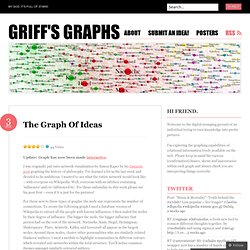
I was originally put onto network visualisation by Simon Raper by his fantastic post graphing the history of philosophy. I’ve learned a lot in the last week and decided to be ambitious. I wanted to see what the entire network would look like – with everyone on Wikipedia. Well, everyone with an infobox containing ‘influences’ and/or ‘influenced by’. For those unfamiliar to this work please see his post first – even if it is just for the pictures! For those new to these types of graphs: the node size represents the number of connections. Method. Cell_experiment.pdf. eVa in K-area.